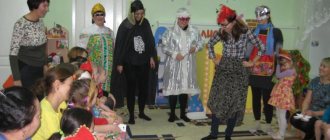Features of speech development in children 4–5 years old
Preschoolers gradually improve all components - phonetics, grammatical structure, vocabulary and coherence.
Features of sound pronunciation
- The first criterion for the development of speech in children aged 4–5 years is phonetics, or sound pronunciation. A 4-year-old child pronounces consonant sounds softly (instead of “spoon” he will say “lezetska”). There is also a lack of clarity in the pronunciation of whistling and hissing sounds - children skip them or replace them;
- Whistling “ts”, “s”, “z” replace: “s” and “ts” - with “f”, “s” - with “t”, “z” - with “d”, “ts” - with "T";
- Hissing “sh”, “sch”, “zh”, “ch” are replaced: “sh” - with “s” or “f”, “zh” - with “z” or “v”, “ch” - with “ ts" or "t", "sch" - to soft "s" or "t";
- The sounds “l” and “r” are often omitted or can be replaced with a soft “l”.
A 5-year-old child perceives and pronounces sounds better and no longer softens them, and does not replace hissing and whistling sounds with other sounds. Children now pronounce many sounds correctly, clearly, with correct articulation. Although some still mispronounce sibilants, "r" and "l".
Complex and long words are abbreviated, syllables are omitted: instead of “car” they will say “atabil”. Here are some other mistakes children make when pronouncing words:
- The sounds are rearranged: “first” - “first”;
- Consonants are skipped when they come together: “big boy” - “barefoot boy”;
- Vowels are inserted in words with a combination of consonants: “I don’t know”, “ship”.
Five-year-old children develop speech at a higher level: they speak more correctly, shorten words less often, change syllables and begin to form words by analogy.
Guys' vocabulary
The second criterion for the development of speech in children aged 4–5 years is the volume of the active vocabulary. By age 4, the vocabulary includes 1000 words.
A 4-year-old child’s volume of active and passive vocabulary is constantly increasing. He talks a lot, loves to listen to rhymes and stories, remembers and retells fairy tales.
A 5-year-old child’s vocabulary doubles – now it contains up to 2000 words.
4-5 year old children are “why”. They are interested in everything in the world and constantly ask their parents questions. To develop speech, it is important to answer questions in detail, provoke a child into dialogue, and look for answers to questions together - all this expands vocabulary.
Grammatical structure of speech
The third criterion for the development of speech in children aged 4–5 years is grammatical design, that is, the complexity of sentences, the sequence and coordination of words.
A 4-year-old child speaks in short and simple sentences. They contain no more than 3–4 words. But speech is gradually improving: phrases become more complex and longer.
The grammatical structure at this age is just being formed, so it is far from perfect. Here are the mistakes children make: they incorrectly arrange the sequence of words (instead of “I don’t want” they will say “I want no”) and incorrectly coordinate the words (“one cat”, “I have three friends”).
By the age of 5, children speak in common and complex phrases, their speech becomes more logical and coherent.
Speech coherence of preschoolers
The fourth criterion is coherence and logic of statements. The first fragments of dialogic speech are already observed in three-year-old children. By the age of 4 - 5 this skill is improved.
In preschoolers, speech development reaches a new level: they can retell a simple fairy tale (“Kolobok”, “Ryaba Hen”). Children cannot yet write a story based on a picture, but they enjoy looking at the illustrations and answering questions about them.
With normal speech development in children aged 4–5 years, the ability to compose stories based on pictures and answer questions about the content of a fairy tale or story is noted. At this age, children enjoy looking at picture books and can talk about their desires and impressions of the cartoon they saw.
How to help your baby with speech development?
Train your articulation muscles. To do this, you can play various games. For example, play hide and seek with your tongue, tap your teeth with it, make it narrow or wide, etc. We invite you to watch a video of exercises for the lips and tongue - articulatory gymnastics:
Here are some more important tips that you can follow to avoid speech disorders and improve your child’s speech.
- Encourage your children's desire to communicate. Let them share their impressions, talk about their interests, ask you and those around you a thousand questions. Try to always find time for this.
- If the child does not want to communicate, stimulate him yourself. Be the conversation starter. Find topics of conversation that will interest your baby.
- Read as many fairy tales, stories, and poems as possible with your child. Sing children's songs together.
- Make crafts with your child (for example, about your favorite fairy tale characters), while communicating and describing each course of action.
- Add game elements to your exercises. Kids are very interested in finger games or puppet theaters.
Useful video about how to develop and shape a child’s speech at 4 years old:
Dear future or current parents, devote enough energy and time to your children! After all, this contributes to their correct and successful development. I hope the article about a child’s speech at 4 years old was useful to you. Leave your comments and share your experience. Goodbye!
Norm of speech development for children 4–5 years old
- Vocabulary – 2500 – 3000 words;
- Invents new words, rhymes;
- Adjectives, complex prepositions, and personal pronouns appear in the vocabulary;
- Periodically groups objects into categories (dishes, fruits, animals);
- Pronounces sounds more clearly and correctly;
- Can say several grammatically formed phrases.
The speech development of children aged 4–5 years is characterized by a sharp leap forward: they willingly talk, rush to speak out, which leads to errors in the logical construction of phrases, sound pronunciation, verb agreement, gender and number.
Exercises for speech development in children 4 – 5 years old
We offer a set of exercises consisting of 4 blocks - to work on each component.
Block 1 for speech development: vocabulary
Exercise 1. Select actions for the subject. Ask your child what each animal does: dog (barks), cat (meows), bird (flies), snake (crawls).
Exercise 2. Selecting signs. Discuss different objects with your child by analogy: what is it? What is it like? He must list as many characteristics of the object as possible (for example, a hat is red, warm, winter, childish).
Exercise 3. Selecting antonyms. Play the game "Reverse". Name the sign, and the baby must name its opposite (for example, snow is white - no, black).
Exercise 4. Learning new words. Thematic pictures by category will be useful: “Clothing”, “Transport”, “Furniture”, “Fruit”, “Vegetables”, “Animals”, “Professions”.
Block 2 for speech development: grammar
Exercise 1. Singular and plural. The parent calls the child a noun in the singular, and he must say it in the plural.
Exercise 2. Learn the genitive plural of nouns. Give your child examples: there is no milk in the glass, there is a lot of snow in the yard, there are no cars on the street.
Exercise 3. We learn to agree adjectives and nouns in number and case, nouns with numerals. Ask your child to answer: which sea is (blue), what color is the ribbon (red), and what color is the sand (yellow). Then count: one egg, and two (eggs)?, two pencils, and six (pencils)?
Exercise 4. Learning to form adjectives from nouns. For example, what kind of leather bag? (leather), what kind of raspberry jam? (raspberry).
You can also practice using prepositions, suffixes, prefixes, and pronouns with the kids.
Block 3 for speech development: phonetics
Exercise 1. Theory. Tell your child about sounds, their position in a word, why they are needed and where they come from.
Exercise 2. Identify the sound in the word. Say any word with an emphasis on a certain sound. Ask your child what sound you indicated. Then ask to answer whether the word has a sound that actually does not exist in it (the child does not know about this).
Exercise 3. Name the words. Choose a sound and ask your child to name the words that begin with it.
Block 4 for speech development: connectivity
Exercise 1. Wimmelbook. A great way to improve speech coherence and teach imagination is to look at pictures in a book and come up with stories about the characters.
Exercise 2: Retelling the story. Tell or read a fairy tale or short story to your child. Ask to retell it.
Exercise 3. Think and draw. Come up with a story together with your child, write it down and draw a comic book for it.
The best way to develop speech and its coherence is to talk a lot with your child, discuss books, cartoons, films, conduct a dialogue, read good books to him.
Working out at home
In difficult cases, sessions with a speech therapist alone will not be enough. Parents will have to work with the child on their own. However, even with a more favorable prognosis, home exercises will only bring benefits. This includes consolidating the skills learned from a speech therapist, and completely at-home games if, for example, it was not possible to find a suitable speech therapist or the problem is not too serious.
Here are a few rules that will help parents properly organize speech therapy classes for children at home.
- Turn every activity into a game. If a child is interested, he learns the necessary skills unobtrusively and quickly.
- Increase the duration of classes gradually: starting from 5 minutes, gradually increasing to 20–35.
- Don't overload your child with information. 2-3 games at a time are quite enough for adequate assimilation of the material.
- Remember to praise. This is the best incentive for a baby.
- Play when the child is alert and in a good mood (after breakfast or lunchtime nap).
- Remember that your baby learns everything by imitating you. Therefore, always show him something by turning him face to face.
- If, when completing a task, you introduce your child to some natural phenomena, structure the work so that they relate to reality (we study snow and frost in winter, leaf fall in autumn).
Buy special literature to help you organize and conduct classes. For example, benefits N.E. Teremkova, T.Yu. Bardysheva, E.N. Monosova. These authors have various benefits for any age.
Diagnosis of speech development disorders in children 4–5 years old
There are several groups of speech disorders:
- Sound pronunciation defects. Articulates sounds incorrectly, replaces and omits them, swaps syllables in words;
- Lexical violations. Poor vocabulary, a 5-year-old child does not understand the meaning of words;
- Connectivity problems. Answers in monosyllables, there are no detailed answers, the narrative is illogical, the structure and grammatical order are broken;
- Melodic intonation defects. Does not control his voice, strength, timbre, pitch are impaired, the voice is inexpressive, monotonous, does not use interrogative and exclamation forms;
- Violation of tempo and rhythm. Speaks quickly or slowly, stammers, stops, speaks words syllable by syllable;
- Misunderstanding of spoken words. The most complex form of speech development disorder listed above.
If you suspect a delayed disorder in your child, do not waste time - show him to a neurologist and speech therapist. The sooner you start correctional work, the faster the child will “catch up” with the age norm for speech development. An excellent solution would be to enroll your child in a speech therapy group in kindergarten.
Let's go to the speech therapist
A child cannot cope with all these speech difficulties on his own. If you do not address them now, this can result in various types of speech retardation, such as delayed speech, psycho-speech development, and general speech underdevelopment. This, in turn, will lead to problems with learning at school. Therefore, timely assistance from a speech therapist for such disorders is mandatory.
A specialist will help the baby not only correct problems with sound production (lisp, lisp, burr), as many people think. A good speech therapist can do much more. The following aspects are within his competence:
- formation of correct speech;
- development of speech structure and vocabulary;
- development of attention, thinking, memory;
- mastering the basics of grammar.
In addition, classes with a speech therapist (if he is an experienced speech pathologist) can help with the following problems:
- stuttering;
- dysarthria;
- underdevelopment of speech with mental retardation;
- alalia;
- rhinolalia;
- dyslexia;
- dysgraphia, etc.
Select your speech therapist carefully. If he says that it will take a year of lessons 4 times a week to set the sound (the usual norm is 2 times), he does not give the child homework (they must be required), he constantly insists on classes to consolidate the sound (parents should do this on their own ), does not allow you to attend classes and at the same time demands a lot of money for your services - feel free to refuse such a “specialist” and look for another.






